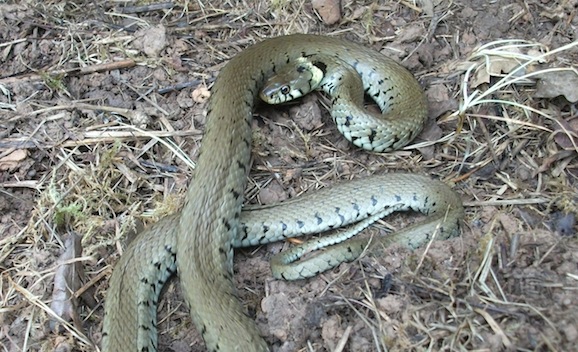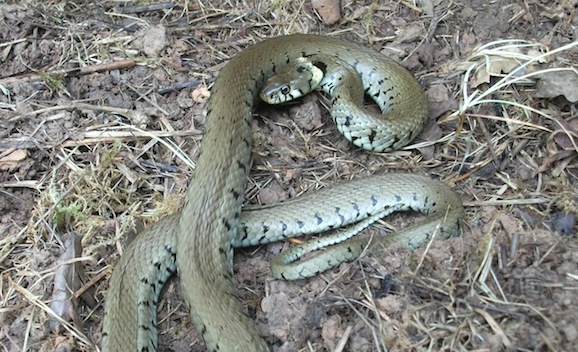The human mind is a complex and wonderful thing. Some images can automatically trigger emotions and actions. For some people, the mere sight of certain wild animals evokes feelings of extreme fear. Topping this list of animals must surely be the snake.
It was a bright August day as I walked out of the visitor centre onto the car park and saw her, coiled up next to a pile of woodchip. As I approached, she started to wiggle her long body and slithered away quickly. Grass snakes are cold blooded so need to bask in the sunshine in order to get their body active. I spotted some broken egg shells on the tarmac. Carefully lifting up some woodchip, I found a clump of around 15 leathery eggs. Grass snakes lay their eggs in compost heaps, piles of woodchip and even dung heaps as this creates a warm microhabitat in which to incubate them. Quite often female snakes can be spotted near where they have laid eggs.
As you are reading this article, tiny juvenile snakes will be hatching from the eggs. The first few months of a baby grass snake’s life are tough. They are very vulnerable to predation and when the chill autumn winds start to blow, they must find a place to hibernate. From the time that they hatch, they do not have any involvement with their parents.
The grass snake is our largest British snake. I have seen female snakes up to three feet long. Despite the size of grass snakes, most people go through life without ever coming into contact with one. This has not always been the case. Early man would have lived a hunter-gatherer lifestyle. Encounters with reptiles such as snakes would have been very common. Some of these snakes would have been poisonous. If humans were to survive, they would have had to spot snakes very quickly and take evasive action.
A fascinating study by a psychologist in Sweden has proven that when people are presented with a slideshow of images, they can recognise images of snakes much more quickly than images of items that are ‘non-dangerous’. This has proven that certain stimuli (such as the sight of snakes) are hard-wired into the human brain because they have been dangerous to our ancestors throughout evolution.
Grass snakes are harmless. They do not have a venomous bite and, when threatened, will either play dead or squirt a foul smelling substance from their anal glands. I find them truly fascinating. The best place to search for grass snakes is under sheets of metal and plastic amongst long grass. These sheets provide a perfect place for them to bask under. They are normally found near water as they feed on frogs, newts and toads and are excellent swimmers.
Our attitude towards snakes has also been affected by cultural factors. In the Bible, a serpent tempts Eve to eat the fruit of the Tree of Knowledge and denies that death will be the result. When Adam and Eve do eat the fruit, they are banished from the Garden of Eden and the serpent is punished by being made to crawl on its belly in the dust. This view of the deceptive serpent that cannot be trusted seems to be inbuilt into the human psyche.
You may think that human perceptions of snakes do not really matter. Unfortunately, our attitudes are very important for the future of British snakes. We have three species of snake in the UK, the other two species being the smooth snake and the adder. The population of adders across the country has dropped dramatically. This includes what used to be a sizeable population in the Wyre Forest. Adders are very sensitive to disturbance. Their habitat has been destroyed and the snakes themselves have been persecuted by people scared of being bitten.
A lot of conservation work in the UK is driven by charities. Charities depend on public support for funding. Animals that are cute and cuddly are easy to sell to the general public as being worthy of conservation. Snakes are not so easy to sell. The long, scale-covered body of a snake harks back to prehistoric times when reptiles dominated the world. When a grass snake is about to shed his skin, his eyes go cloudy and his sight becomes impaired. I only hope that humans can have a clearer vision about how best to conserve these incredible animals. The countryside would be a poorer place without them.
Do one thing for wildlife this month:
Grass snakes are common visitors to gardens. Why not do your bit for conservation and make your garden snake-friendly? The best feature to build is a compost heap. Pile up your grass cuttings and create a perfect egg-laying site for snakes. Try and ensure that the compost heap is not completely shaded so that it gets nice and warm to incubate the eggs.
A garden pond will further enhance your chances of seeing a grass snake. Areas of short-mown grass around the pond edge provide great basking areas and need to be interspersed with longer grass for the snakes to forage in. If you have space, place some sheets of corrugated tin amongst the long grass to give further basking areas.







